Was he a military man who saw the Army evolve from horse cavalry to motorized cavalry, or was he a railroad man who saw trains evolve from steam locomotives to diesel engines?
The answer is “yes.”
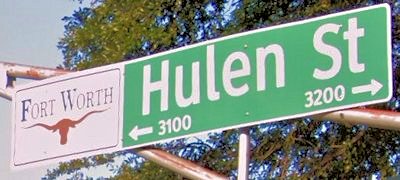 But today we are most likely to be reminded of the man who led two lives when we drive on his namesake street.
But today we are most likely to be reminded of the man who led two lives when we drive on his namesake street.
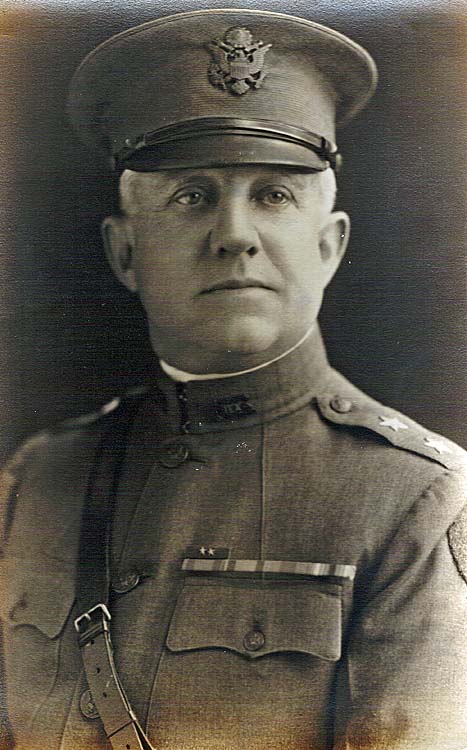 John Augustus Hulen was born in 1871 in Missouri to Harvey and Frances Hulen. (Photo from Wikipedia.)
John Augustus Hulen was born in 1871 in Missouri to Harvey and Frances Hulen. (Photo from Wikipedia.)
 In 1873 the Hulens moved to Gainesville in Cooke County.
In 1873 the Hulens moved to Gainesville in Cooke County.
Military Man
After attending Gainesville public schools, John attended Staunton Military Academy in Virginia and Marmaduke Military Academy in Missouri. Upon graduating from Marmaduke in 1889 he joined Company G of the 3rd Texas Volunteer Infantry (known as the “Gainesville Rifles”) as a private. Two years later he was commissioned as a first lieutenant.
 Hulen was promoted to captain in 1893 when a cavalry troop of the Texas Volunteer Guards was organized in Gainesville.
Hulen was promoted to captain in 1893 when a cavalry troop of the Texas Volunteer Guards was organized in Gainesville.
During the Spanish-American War Hulen was a major in the cavalry of the U.S. Volunteers. He became a lieutenant colonel in 1898 and served until the regiment was mustered out in November.
When the Philippine insurrection broke out in 1899 Hulen was appointed an infantry captain in the 33rd U.S. Volunteers. He fought insurrectionists for eighteen months in the jungle of northern Luzon. The Star-Telegram wrote in 1917 that while Hulen was pursuing the insurrection leader Emilio Aguinaldo, Hulen and his men fought with little food for twenty days. By the time Aguinaldo’s army was defeated, the newspaper wrote, Hulen was “shoeless, hatless and sleeveless, and ‘shaveless.’” Hulen was awarded a Silver Star for gallantry in action during the insurrection.
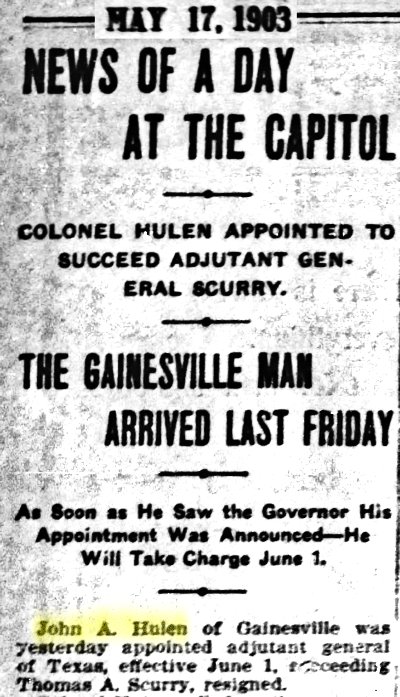 Hulen in 1903 was appointed adjutant general of the Texas National Guard.
Hulen in 1903 was appointed adjutant general of the Texas National Guard.
 In 1907 Hulen, with the rank of brigadier general at age thirty-six, retired from the Texas National Guard.
In 1907 Hulen, with the rank of brigadier general at age thirty-six, retired from the Texas National Guard.
His retirement lasted nine years.
In 1916, the Star-Telegram wrote in 2004, Hulen was negotiating with Mexico for rights-of-way and land grants to allow the Trinity & Brazos Valley railroad (see below) to pass through Mexico on a route to the Panama Canal. But before negotiations could be concluded, Mexican revolutionary Pancho Villa began terrorizing the international border along Texas, Arizona, and New Mexico.
So, Hulen shunted his railroad career onto a siding and resumed his military career. He returned to active duty in command of Texas troops on the Mexican border as the United States pursued Villa in 1916-1917.
Late in 1917 as America entered World War I Hulen fulfilled the Texas quota of National Guardsmen to complete the 36th Division, made up of men from Texas and Oklahoma. The division was stationed at Fort Worth’s Camp Bowie.
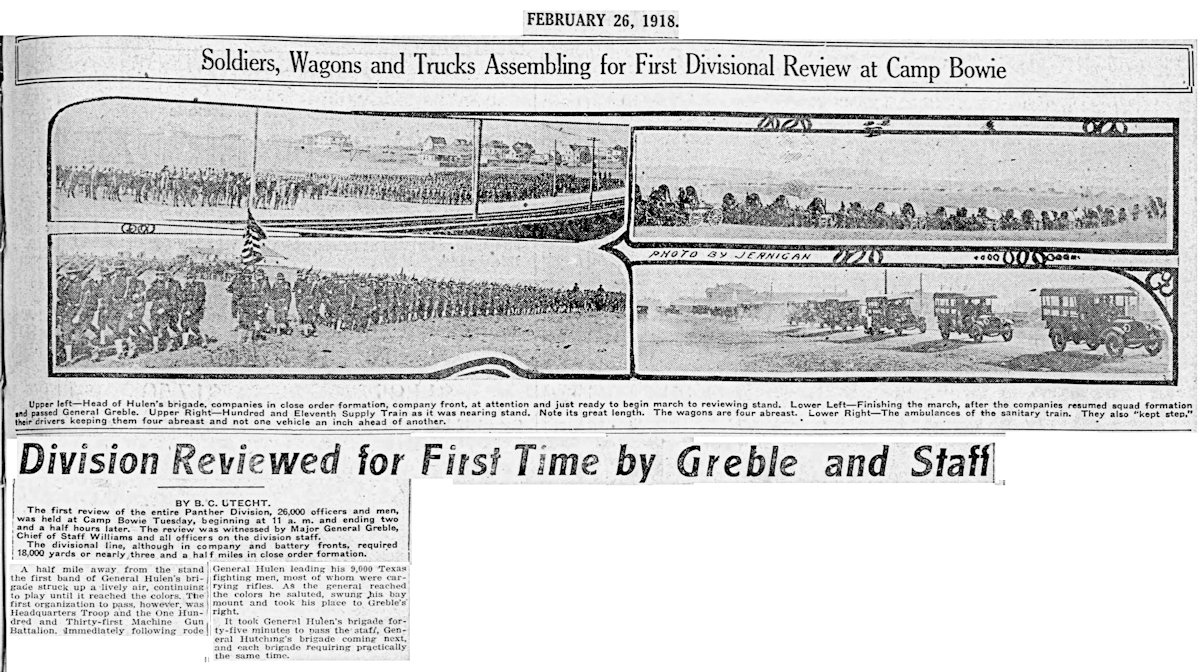 Hulen then was appointed brigadier general, U.S. Army, commanding the 72nd Infantry Brigade of the 36th Division. He commanded the brigade during its training at Camp Bowie. In 1918 camp commander General Edwin St. John Greble, Hulen, and other officers reviewed the twenty-six thousand men of the 36th Division. The Star-Telegram wrote that it took Hulen’s nine thousand men forty-five minutes to march past the reviewing stand.
Hulen then was appointed brigadier general, U.S. Army, commanding the 72nd Infantry Brigade of the 36th Division. He commanded the brigade during its training at Camp Bowie. In 1918 camp commander General Edwin St. John Greble, Hulen, and other officers reviewed the twenty-six thousand men of the 36th Division. The Star-Telegram wrote that it took Hulen’s nine thousand men forty-five minutes to march past the reviewing stand.
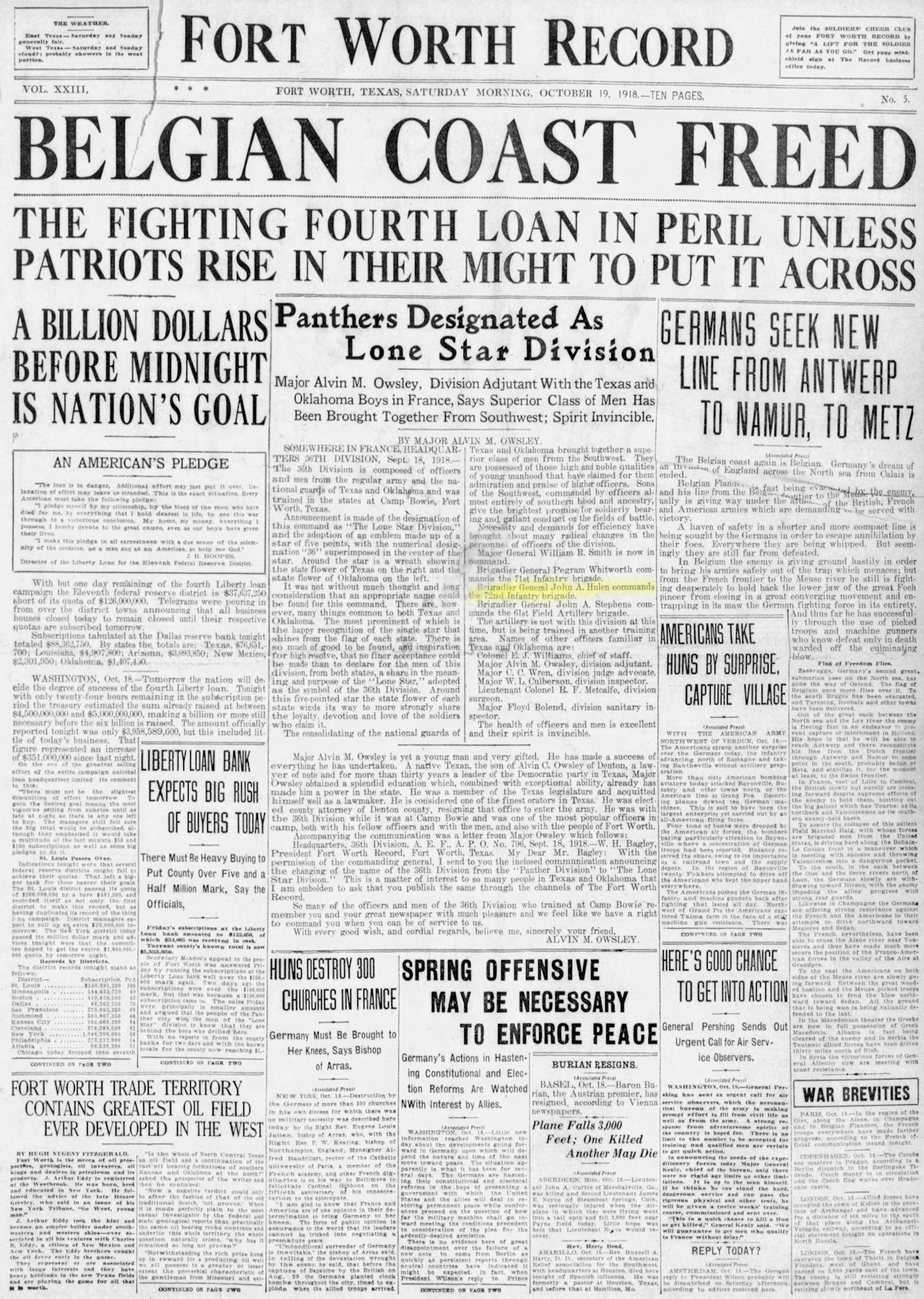 Hulen’s 72nd Brigade fought in some of the fiercest battles of the war: Champagne-Marne and Meuse-Argonne. At Meuse-Argonne the 36th Division fought continuously from October 12 to October 27, 1918. Hulen was twice awarded France’s Croix de Guerre for service in the Champagne-Marne offensive. He also was awarded the United States Silver Star and Distinguished Service Medal for service at Meuse-Argonne. The Meuse-Argonne citation noted Hulen’s “conspicuous leadership, great tactical knowledge, and keen judgment, which were material factors in the success attained by this brigade.”
Hulen’s 72nd Brigade fought in some of the fiercest battles of the war: Champagne-Marne and Meuse-Argonne. At Meuse-Argonne the 36th Division fought continuously from October 12 to October 27, 1918. Hulen was twice awarded France’s Croix de Guerre for service in the Champagne-Marne offensive. He also was awarded the United States Silver Star and Distinguished Service Medal for service at Meuse-Argonne. The Meuse-Argonne citation noted Hulen’s “conspicuous leadership, great tactical knowledge, and keen judgment, which were material factors in the success attained by this brigade.”
In 1920 Hulen was promoted to the rank of major general in the Texas National Guard.
 By 1920 an Arlington Heights street had been named for General Hulen. Hulen Street passed just west of where the barracks of General Hulen’s 72nd Infantry Brigade had been located at Camp Bowie. By 1925 Hulen Street was less than two miles long, running from Crestline Road south to the city limits, then located just below Lake Como. Today Hulen Street runs eleven miles through the west and south sides of town to the current city limits.
By 1920 an Arlington Heights street had been named for General Hulen. Hulen Street passed just west of where the barracks of General Hulen’s 72nd Infantry Brigade had been located at Camp Bowie. By 1925 Hulen Street was less than two miles long, running from Crestline Road south to the city limits, then located just below Lake Como. Today Hulen Street runs eleven miles through the west and south sides of town to the current city limits.
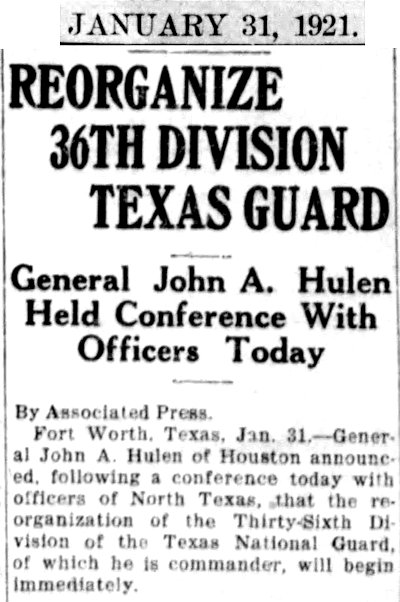 In 1921 Hulen was named commander of the entire 36th Division, which he reorganized.
In 1921 Hulen was named commander of the entire 36th Division, which he reorganized.
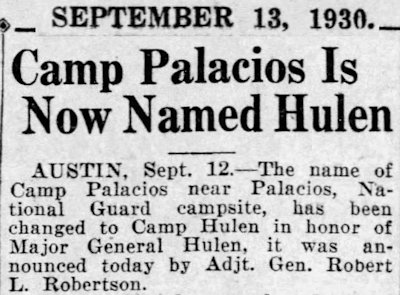 In 1930 Camp Palacios on Matagorda Bay on the gulf coast was renamed for Hulen.
In 1930 Camp Palacios on Matagorda Bay on the gulf coast was renamed for Hulen.
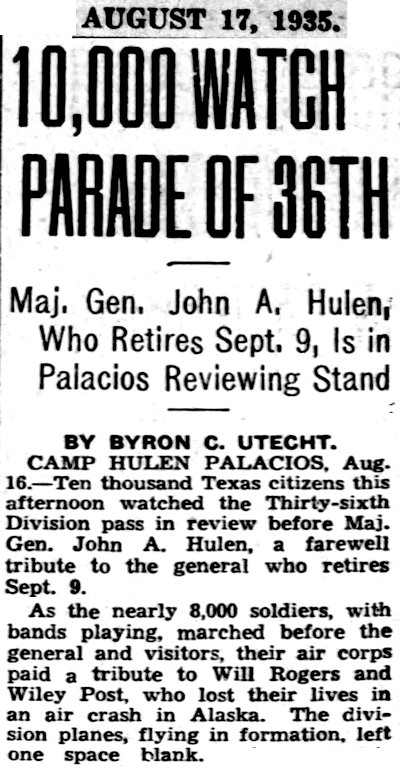 Hulen remained commander of the 36th Division until his second retirement in 1935. In a ceremony at Camp Hulen, Hulen reviewed eight thousand troops. Governor James Allred promoted Hulen to the rank of lieutenant general, the National Guard’s highest rank. Note that airplanes of the division also flew a formation in tribute to Will Rogers and Wiley Post, who had recently been killed in an airplane crash.
Hulen remained commander of the 36th Division until his second retirement in 1935. In a ceremony at Camp Hulen, Hulen reviewed eight thousand troops. Governor James Allred promoted Hulen to the rank of lieutenant general, the National Guard’s highest rank. Note that airplanes of the division also flew a formation in tribute to Will Rogers and Wiley Post, who had recently been killed in an airplane crash.
John A. Hulen during his long military career had served under two Generals MacArthur—father Arthur and son Douglas—and General John J. Pershing.
Railroad Man
When John A. Hulen was not wearing a uniform he was wearing a suit as his railroad career intertwined with his military career.
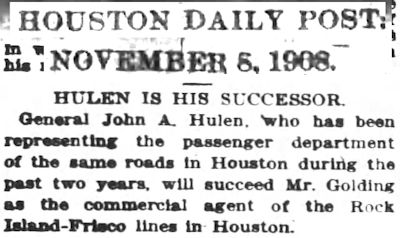
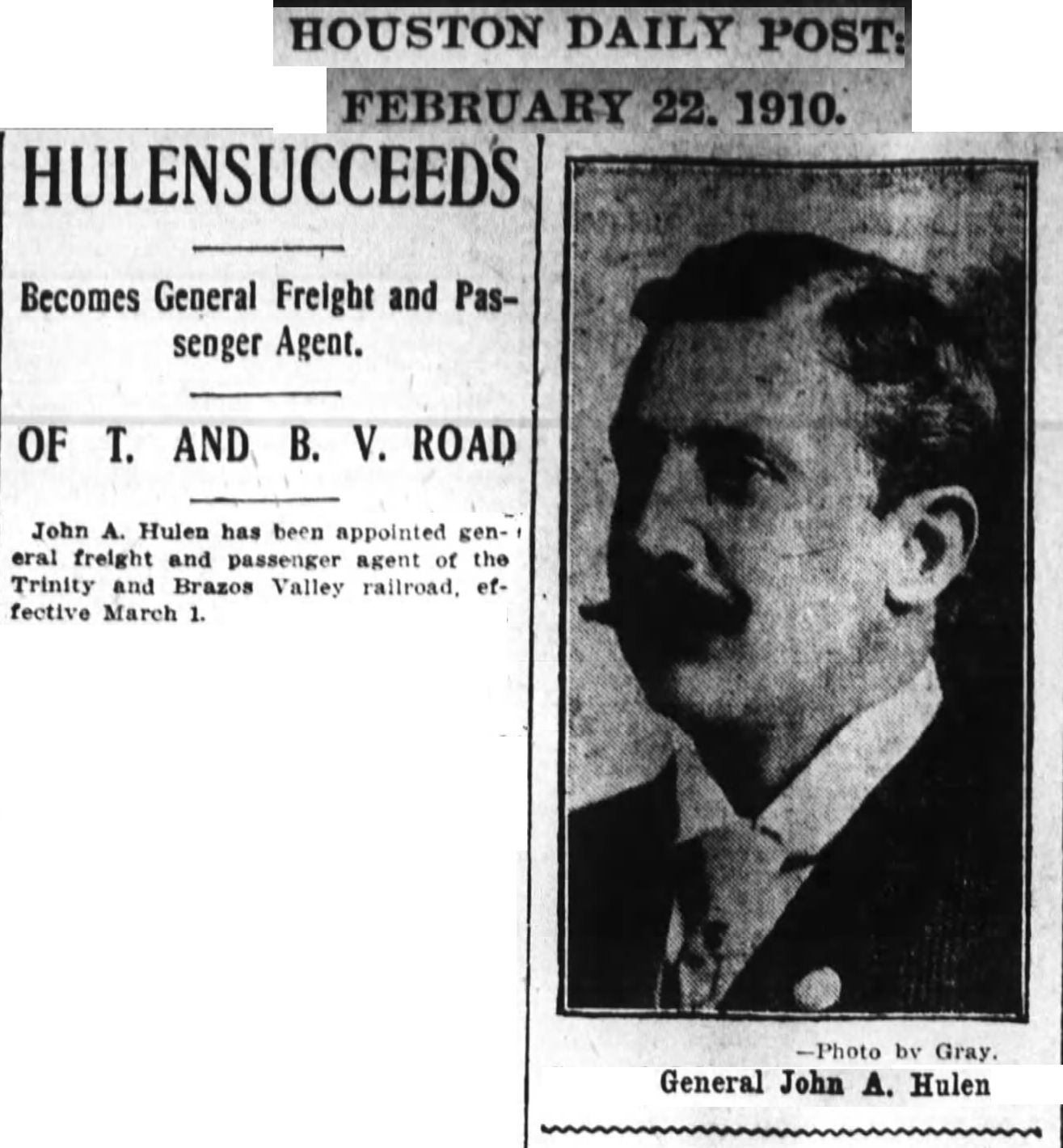 Hulen began his railroad career as a teenager, working as a telegrapher. In 1896 he became general agent for the Missouri, Kansas and Pacific railroad in Lindsay near Gainesville. In 1908 he became commercial agent in Houston for the Rock Island-Frisco lines. And in 1910 he became general freight and passenger agent for the Trinity & Brazos Valley railroad.
Hulen began his railroad career as a teenager, working as a telegrapher. In 1896 he became general agent for the Missouri, Kansas and Pacific railroad in Lindsay near Gainesville. In 1908 he became commercial agent in Houston for the Rock Island-Frisco lines. And in 1910 he became general freight and passenger agent for the Trinity & Brazos Valley railroad.
In 1914 the Trinity & Brazos Valley went into receivership. In 1919 Hulen took a giant stride in his railroad career: He was appointed receiver of the T&BV. And he made the railroad profitable again.
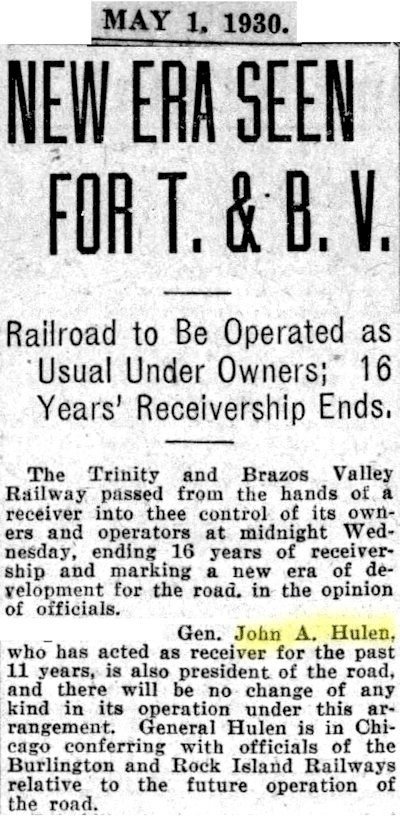 When the T&BV reorganized as the Burlington-Rock Island railroad in 1930, Hulen was its president.
When the T&BV reorganized as the Burlington-Rock Island railroad in 1930, Hulen was its president.
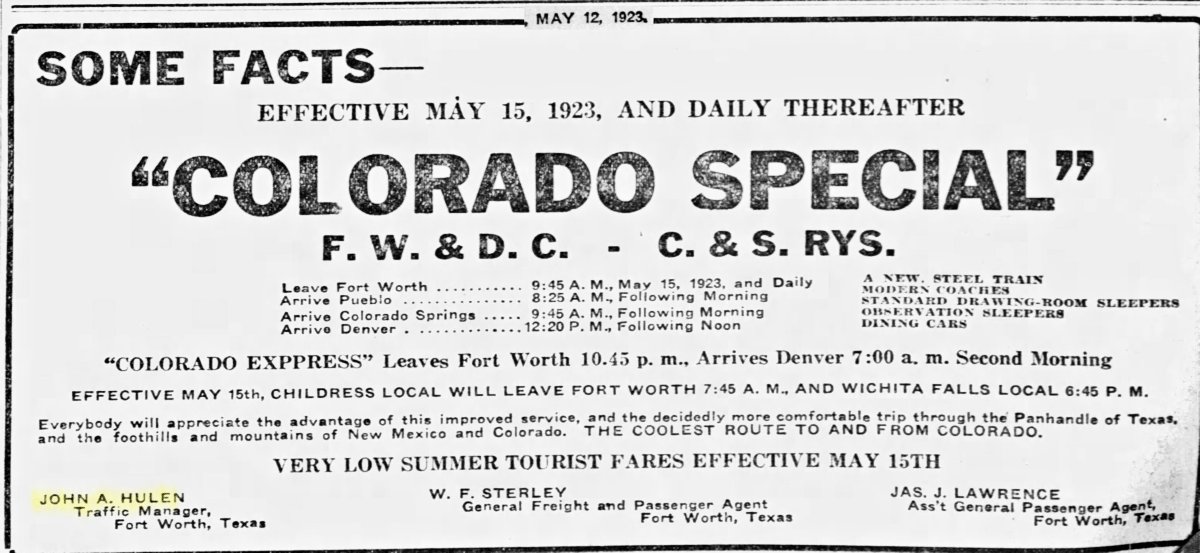 Likewise, in 1920 Hulen had become traffic manager of the Fort Worth & Denver City railroad.
Likewise, in 1920 Hulen had become traffic manager of the Fort Worth & Denver City railroad.
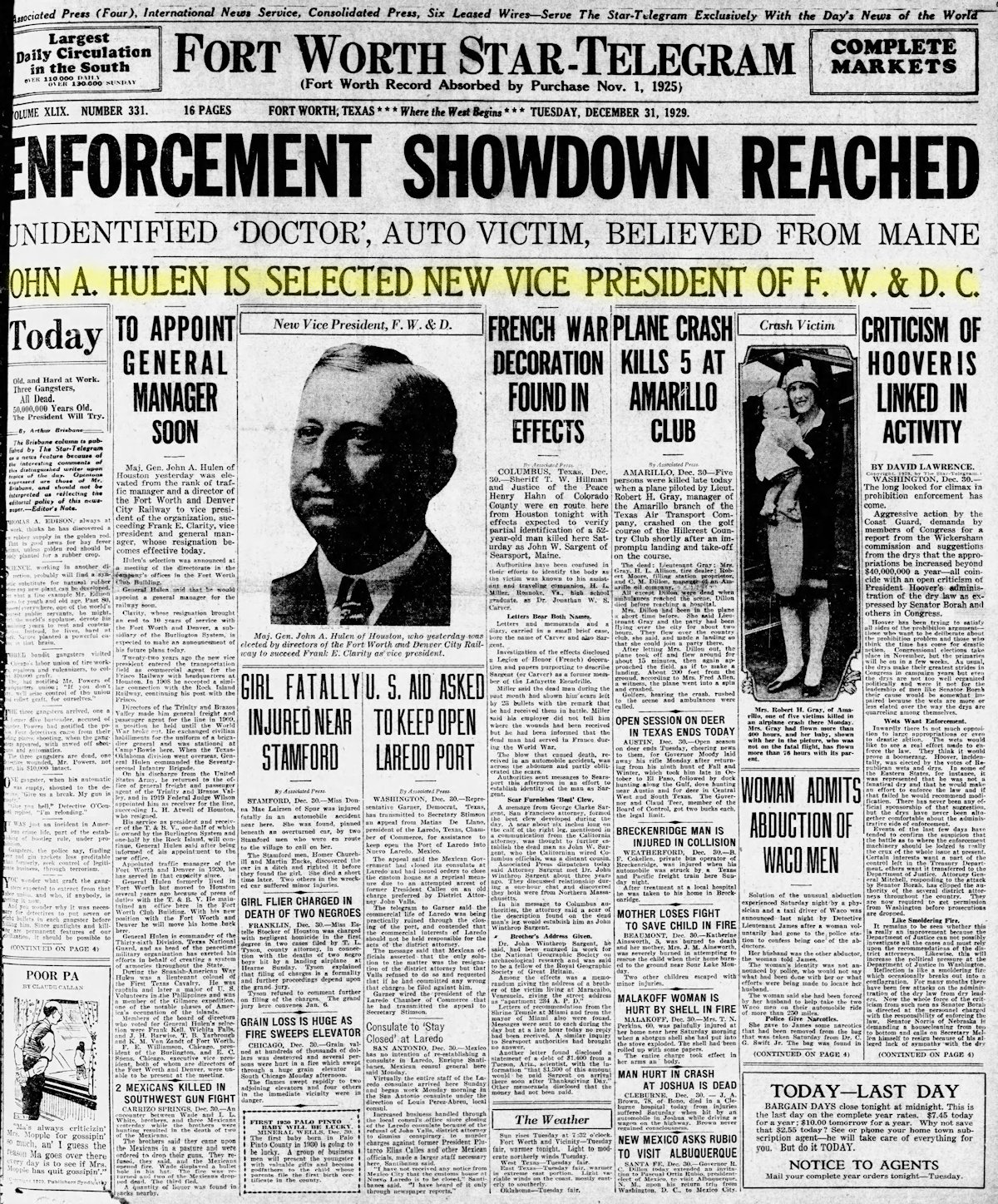 And in 1929 Hulen took another giant stride: He was promoted to vice president of the FW&DC.
And in 1929 Hulen took another giant stride: He was promoted to vice president of the FW&DC.
 With his new position, Hulen moved from Houston to Fort Worth about 1930, living in an apartment on Forest Park Boulevard.
With his new position, Hulen moved from Houston to Fort Worth about 1930, living in an apartment on Forest Park Boulevard.
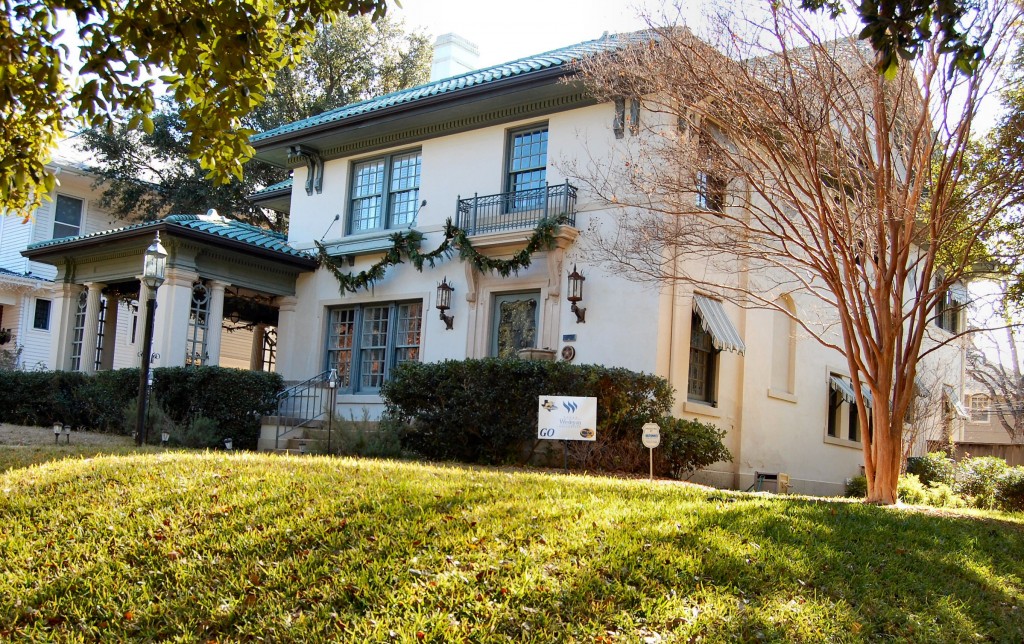
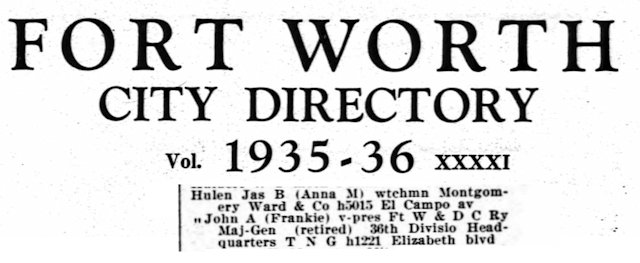 In 1935, as befits a man who was president of one railroad and vice president of another, Hulen bought the house at 1221 Elizabeth Boulevard in Ryan Place. The house (1922, Clarkson) had been built for oilman T. B. Hoffer.
In 1935, as befits a man who was president of one railroad and vice president of another, Hulen bought the house at 1221 Elizabeth Boulevard in Ryan Place. The house (1922, Clarkson) had been built for oilman T. B. Hoffer.
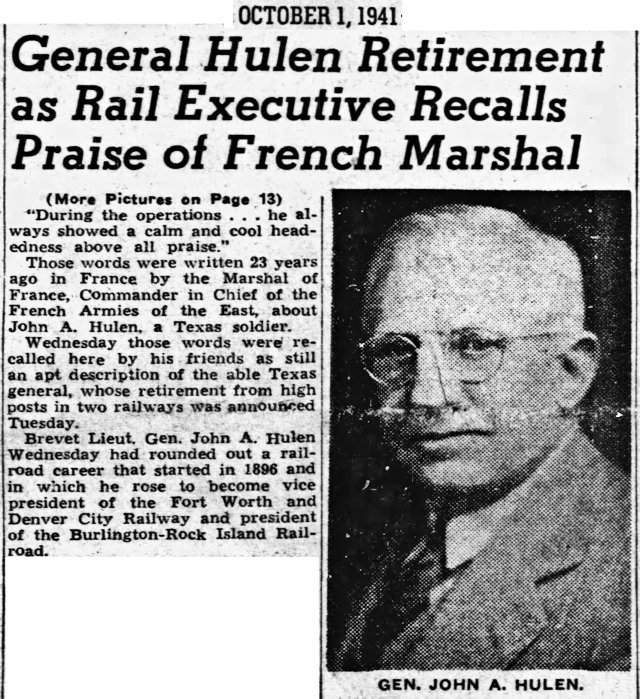 General Hulen bivouacked in the Hoffer-Hulen house from 1935 until his third retirement in 1941: He retired as vice president of the Fort Worth & Denver and as president of the Burlington-Rock Island. He remained chairman of the board of BRI.
General Hulen bivouacked in the Hoffer-Hulen house from 1935 until his third retirement in 1941: He retired as vice president of the Fort Worth & Denver and as president of the Burlington-Rock Island. He remained chairman of the board of BRI.
John A. Hulen, twice retired from the military and once retired from railroading, remained close to military life. He moved from Fort Worth to the town of Palacios on Matagorda Bay and built a home across the road from the camp named for him.
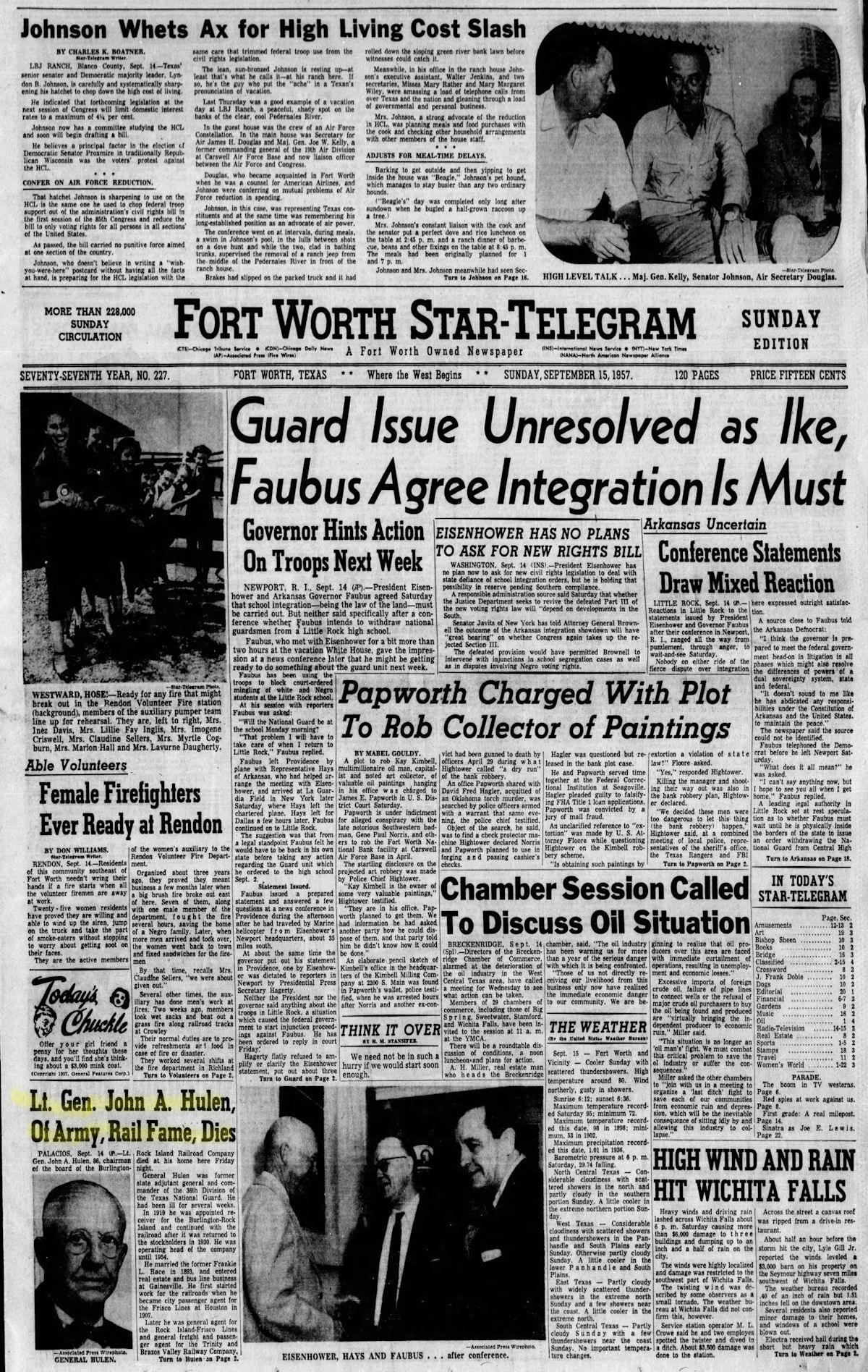 General Douglas MacArthur, upon his own retirement, told a joint session of Congress: “Old soldiers never die.” But old railroad men do. John A. Hulen died in 1957 at the age of eighty-six.
General Douglas MacArthur, upon his own retirement, told a joint session of Congress: “Old soldiers never die.” But old railroad men do. John A. Hulen died in 1957 at the age of eighty-six.
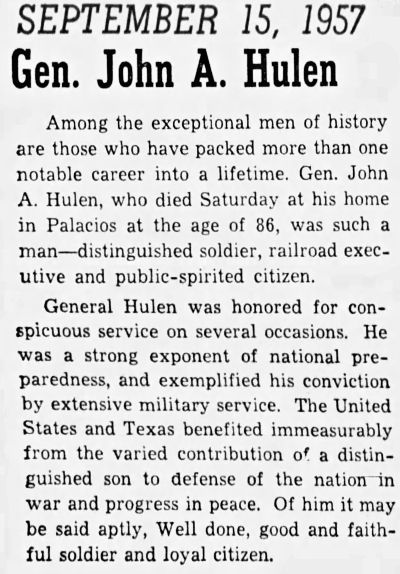 The Star-Telegram eulogized Hulen as a “good and faithful soldier and loyal citizen.”
The Star-Telegram eulogized Hulen as a “good and faithful soldier and loyal citizen.”
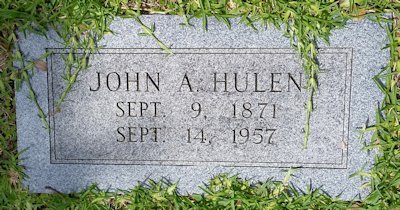 John Augustus Hulen, the man who led two lives, is buried in Houston.
John Augustus Hulen, the man who led two lives, is buried in Houston.





